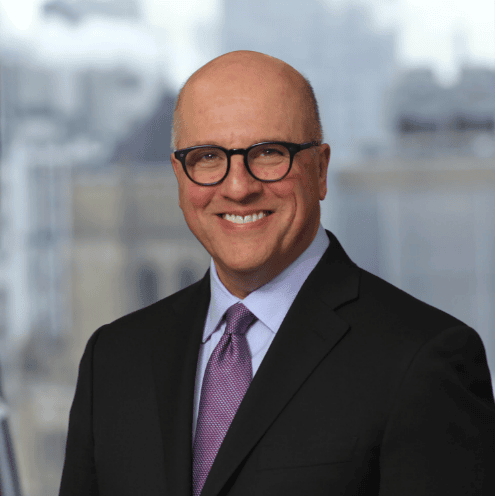
A Thank You to Richard Bernstein
I recently decided to break out my copy of "Navigate the Noise" by Richard Bernstein, a book he wrote in 2001. The first thing that struck me was the full title, and how it seems so appropriate today. The full title is: "Navigate the Noise: Investing in the New Age of Media and Hype", which
For context, Richard Bernstein is the CEO & Chief Investment Officer of Richard Bernstein Advisors. He was formerly the Chief Investment Strategist at Merrill Lynch, where I became familiar with his work, as he would often be heard on the daily market calls, providing insight and guidance for advisors. What stands out in my memory is that there were some people in our office who were not his biggest fans. Perhaps it was because he wasn't always an equity market "cheerleader", as some are, or because he suggested caution in an approach rather than to "back the truck up and buy as much as you can." (That's another actual quote that I heard from a different analyst - WOW!). However, I liked his style, and always appreciated the independent, well-thought out logic as well as how he articulated his opinion.
With that in mind, in this era of seemingly overvalued markets and an uncertain economy, I think it could be helpful to step back, take a breath, and evaluate what is going on with a well-known framework, the PEST Analysis. PEST stands for "Political; Economic; Social; Technological". (Some choose to use PESTLE, adding "Legal & Environmental" as additional factors to consider.
1. Political
- Escalating Tariff Tensions & Trade Policy ShockwavesThe U.S. has imposed sweeping tariffs—the highest since the 1930s—averaging almost 20%, impacting imports from more than 60 countries and pressuring trade flows, inflation, and consumer costs (The Tax Foundation).
- Temporary Relief via Trade TruceA fresh 90-day truce between the U.S. and China offers short-term calm, though significant diplomatic and trade hurdles remain unresolved (AP News).
- Federal Reserve Policy Amid UncertaintyAmid persistent inflation and slowing growth, Kansas City Fed President Schmid supports holding rates steady around 4.25–4.50%, calling the policy “modestly restrictive” (Reuters). In contrast, economist Jeremy Siegel argues that a rate cut is “inevitable,” forecasting up to a 50-basis-point cut in September and further easing into 2026 (MarketWatch).
2. Economic
- Mixed Growth SignalsThe U.S. economy rebounded in Q2 2025 with annualized GDP growth of +3.0%, after a Q1 contraction of –0.5% (Bureau of Economic Analysis, Gallagher).
- Global Growth Outlook—Tempered but SteadyThe IMF raised its global growth forecast to 3.0% for 2025, buoyed by pre-tariff spending and easing effective U.S. tariffs. Still, downside risks remain high (Reuters). The OECD paints a bleaker picture, warning of the weakest global expansion since the pandemic, citing trade barriers and policy uncertainty as key drags (Financial Times).
- Inflation Pressures PersistU.S. headline CPI held at 2.7% while core CPI rose to 3.1%—indicating stickier inflation driven in part by tariffs (New York Post, The Guardian). The re-emergence of stagflation—a troubling combo of slowed growth and high inflation—is increasingly discussed by economists (Financial Times).
3. Social
- Softening Labor Market & Job Data ShiftsJob growth slowed markedly—July added just 73,000 jobs, the weakest performance since the COVID-19 downturn. Revisions also showed May and June estimates were overstated by 258,000 jobs collectively (The Times of India).
- Shifting Investor SentimentMarkets are rapidly digesting inflation trends, Fed signals, and tariff impacts. Record highs in some indices reflect optimism, but stagflation concerns are sowing caution (Business Insider, The Times).
- Skepticism in Real Estate InvestmentsRay Dalio calls real estate a risky bet in the current environment—pointing to its rate sensitivity, tax burden, and illiquidity—and recommends hedging via gold or Bitcoin instead (Business Insider).
4. Technological
- Market Preferences Favoring Tech & AITechnology and AI-related sectors continue to outperform, reflecting investors’ preference for scalable, less tariff-sensitive businesses (Quotient Wealth, Schroders).
- AI as a Growth EngineAI and cloud services delivered strong earnings from major firms like Microsoft and Alphabet, reinforcing optimism about AI’s long-term profitability (Schroders).
- Supply Chain Resilience & ReconfigurationGlobal supply chains are recalibrating amid layered crises—geopolitical fragmentation, pandemic remnants, and Russia-Ukraine fallout. While China remains deeply embedded upstream, importers are increasingly diversifying toward ASEAN partners (arXiv).
Summary Table: PEST Snapshot
| PEST Factor | Key Developments |
|---|---|
| Political | Tariff turbulence; Temporary U.S.–China truce; Diverging Fed outlook |
| Economic | U.S. GDP rebounds; Inflation resilient; Global growth modest |
| Social | Labor market cooling; Real estate skepticism; Market sentiment mixed |
| Technological | Tech/AI outperforming; Supply chain realignment in progress |
Concluding Thoughts
The emerging economic narrative for mid-2025 is one of fragile resilience amid growing uncertainty. Markets are balancing optimism—rooted in tech gains and a potential Fed pivot—with geopolitical risks, inflation pressures, and softening fundamentals. A rate cut could provide relief, but reliance on policy lightening is fraught amid stagflation fears. From a PEST standpoint, navigating this period requires vigilance across domains: watch tariff developments, inflation and labor indicators, investor confidence shifts, and the adaptive power of tech and supply chains.
For a more in depth opinion on what this may mean for your plan and portfolio, click the button below to schedule a call.
Disclaimer: This content has been generated with AI assistance and is for informational purposes only. It should not be considered professional, legal, or financial advice. Please consult a qualified expert for specific guidance.